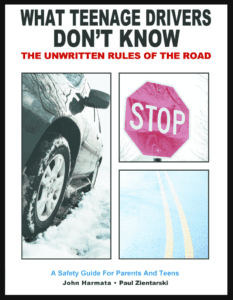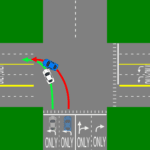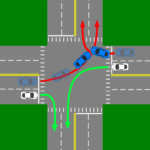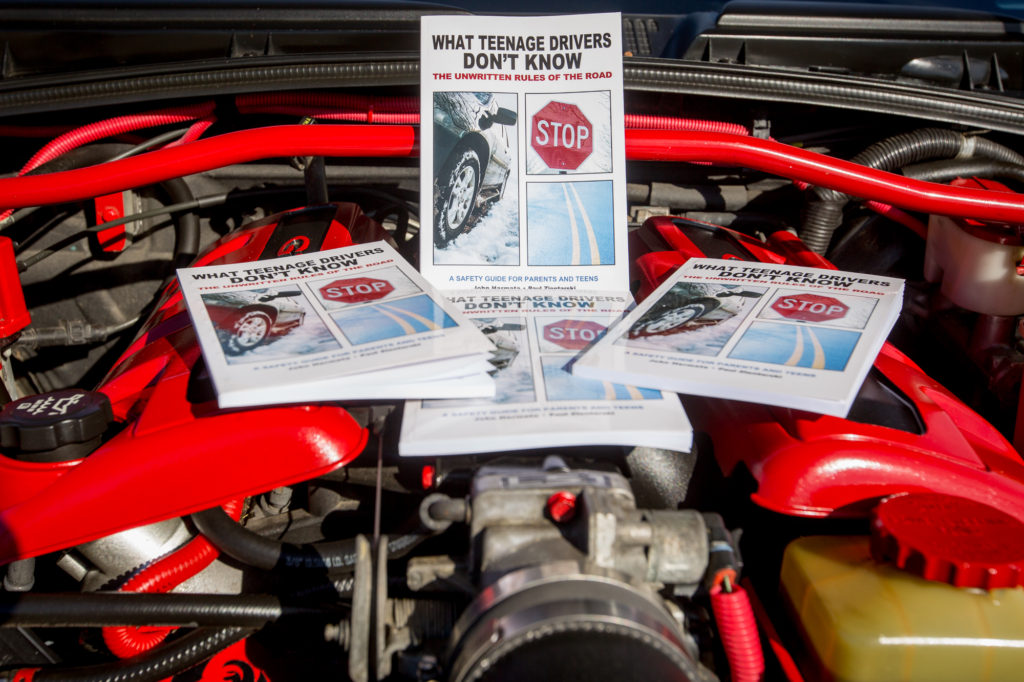Mark Quitter Racing is a proud supporter of “Safe Teen Driving”
| Donate $25 today, and as a “Thank You”, I will send you a copy of the award-winning book: “What Teenage Drivers Don’t Know, The Unwritten Rules Of The Road” |
| “The statistics of teenage driving accidents are frightening, and it is important that we all do our part to help young new drivers stay safe by giving parents the tools they need to protect their child from becoming another number.” |
Current Teenage Driver Statistics
Courtesy of: The Center for Disease Control and Prevention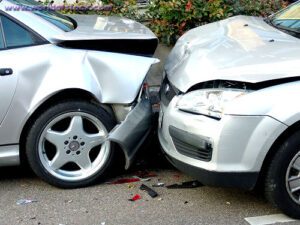
| “In 2018, almost 2,500 teens in the United States aged 13–19 were killed, and about 285,000 were treated in emergency departments for injuries suffered in motor vehicle crashes. That means that every day, about seven teens aged 13–19 died due to motor vehicle crashes, and hundreds more were injured. In addition, fatal and nonfatal motor vehicle crash injuries among teens 13–19 years of age resulted in about $11.8 billion in medical and work loss costs for crashes that occurred in 2018.” |
Who is most at risk?
The risk of motor vehicle crashes is higher among 16-19-year-olds than among any other age group. In fact, per mile driven, teen drivers ages 16 to 19 are nearly three times more likely than drivers aged 20 and older to be in a fatal crash.
Among teen drivers, those at especially high risk for motor vehicle crashes are:
- In 2018, the motor vehicle death rate for male drivers aged 16–19 was almost two times higher than the death rate for female drivers of the same age.
- Teens driving with teen passengers: The presence of teen passengers increases the crash risk of unsupervised teen drivers. This risk increases with the number of teen passengers.
- Newly licensed teens: Crash risk is particularly high during the first months of licensure. The fatal crash rate per mile driven is nearly twice as high for 16-17 year olds as compared to 18-19 year olds.
What factors put teen drivers at risk?
Inexperience:
- Teens are more likely than older drivers to underestimate dangerous situations or not be able to recognize dangerous situations. Teens are also more likely than adults to make critical decision errors that lead to serious crashes.
- In 2018, 37% of motor vehicle crash deaths among teen drivers and passengers aged 13–19 occurred between 9 pm and 6 am, and 52% occurred on Friday, Saturday, or Sunday.
Not Using Seat Belts:
- Compared with other age groups, teens and young adults often have the lowest seat belt use rates. For example, results from the National Occupant Protection Use Survey (NOPUS) Controlled Intersection study from 2016 to 2018 indicate that seat belt use among teens and young adults (16–24 years of age) was approximately 87% each year, whereas seat belt use among adults (25 years of age or older) was 90% or higher for each year during the same period.
- In 2019, 43.1% of U.S. high school students did not always wear a seat belt when riding in a car driven by someone else.
- Among teen drivers and passengers 16–19 years of age who died in car crashes in 2018, almost half were unrestrained at the time of the crash (when restraint use was known).
Distracted Driving:
- Teens are more likely than older drivers to speed and allow shorter headways (the distance from the front of one vehicle to the front of the next).
- Results from the 2019 national Youth Risk Behavior Survey revealed that, among U.S. high school students who drove, 39.0% texted or e-mailed while driving at least once during the 30 days before the survey.
Speeding:
- Teens are more likely than older drivers to speed and allow shorter headways (the distance from the front of one vehicle to the front of the next). The presence of male teenage passengers increases the likelihood of this risky driving behavior.
- In 2018, 30% of male drivers aged 15–20 years and 18% of female drivers aged 15–20 years who were involved in fatal crashes were speeding. These were the highest percentages by sex as compared with all other age groups.
Alcohol Use:
- Drinking any amount of alcohol before driving increases crash risk among teen drivers as compared with older drivers. Teen drivers have a much higher risk for being involved in a crash than older drivers at the same blood alcohol concentration (BAC), even at BAC levels below the legal limit for adults.
- Results from the 2019 national Youth Risk Behavior Survey revealed the following:
- Among U.S. high school students who drove, 5.4% drove when they had been drinking alcohol at least once during the 30 days before the survey.
- Driving after drinking alcohol was higher among students who were older, male, Hispanic, or had lower grades.
- 16.7% of U.S. high school students rode with a driver who had been drinking alcohol at least once during the 30 days before the survey.
- Riding with a drinking driver was higher among Hispanic students or students with lower grades.
- Students who engaged in any of the other transportation risk behaviors measured by the survey were approximately 3–13 times as likely to have also engaged in driving after drinking alcohol at least once during the 30 days before the survey.
- Drinking alcohol is illegal for individuals less than 21 years of age, as is driving after drinking any amount of alcohol. Despite this, in 2017, 24% of drivers aged 15–20 who were killed in fatal motor vehicle crashes had been drinking.
- In 2018, 15% of drivers aged 16–20 involved in fatal motor vehicle crashes had a BAC of 0.08% or higher – a level that is illegal for adults aged 21 or older in all U.S. states (Note: Utah has a BAC limit of 0.05%).
- In 2017, 58% of drivers aged 15–20 who were killed in motor vehicle crashes after drinking and driving were not wearing a seat belt (based on known restraint use).
- For young drivers involved in fatal crashes, alcohol involvement is typically higher among male drivers than among female drivers. In 2017, 20% of male drivers aged 15–20 years and 15% of female drivers aged 15–20 years involved in fatal crashes had been drinking prior to the crash.
The CDC is just one organization of many who post-teenage driving statistics. The 2019 statistics are still being reviewed, as most posted statistics are at least 2 years behind. This means we need to share as much information and knowledge with young inexperienced teenage drivers now before it is too late!
The recently published book, “What Teenage Driver’s Don’t Know – The Unwritten Rules of the Road”, can literally help save teenage drivers’ lives.
This book takes the art of skillful driving to a whole new level in teenage driver training. “What Teenage Drivers Don’t Know, the Unwritten Rules of the Road will increase a teenager’s ability to drive smarter and safer.
“What Teenage Drivers Don’t Know, The Unwritten Rules of the Road” teaches driving strategies and tips to teenagers about driving in poor conditions, parking, vehicle maintenance, surviving the unexpected and even navigating the court system.
We are proud to announce that this book is currently being used as part of the driver’s education curriculum in Naperville, Illinois School Districts #203 and #204.
Example Book Diagrams:
- Correct and incorrect Left Turn: 2 Turn Lanes
- Correct and Incorrect Left Turn: single lane
| Donate $25 today, and as a “Thank You” we will send you a copy of the award-winning book: “What Teenage Drivers Don’t Know, The Unwritten Rules Of The Road” |
- Authors John Harmata (left) and Paul Zientarski (right) with Illinois Secretary of State Jesse White.
- Official Book launch at Anderson’s Book Shop, Naperville Illinois
About The Authors:
- John Harmata – Author of “What Teenage Drivers Don’t Know – The Unwritten Rules of the Road”
- Paul Zientarski – Author of “What Teenage Drivers Don’t Know – The Unwritten Rules of the Road”
John Harmata
John Harmata, business owner and entrepreneur, was born and raised in Chicago, Illinois. In 1978, John started his own business; servicing figure skaters from beginner up to national level competitors. In the fall of 2000, a member of U.S. Figure Skating heard about his work and asked if he would be interested in contributing an article to Skating magazine. John has been writing the Ask Mr. Edge column for U.S. Figure Skating magazine for more than ten years. John’s articles also appear at LenSaunders.com.
In May 2013, John published his first book, Anatomy of a Figure Skating Injury, which received a Global EBook Silver Medal award in the Non-Fiction Sports/Fitness/Recreation category.
His concern for child safety has been a priority in life. Raising two children together with his wife, John has experienced the concern parents have for their children as they take those first steps toward independence and begin to drive. John, creator and lead author believes that: What Teenage Drivers Don’t Know, The Unwritten Rules of the Road will help protect our most valuable possessions – our children’s lives.
Paul Zientarski, MS
Paul Zientarski has dedicated 40 years of his life to teaching students physical education, culminating his career as Department Chairman for Physical Education, Health, and Driver Education. As the Department Chairman for Driver Education, Paul’s responsibilities included staff development, supervision, and film reviews for Simulator Systems, Inc.
Paul holds a BS in Physical Education and an MS in Communication Science, along with an Administrative Certificate. Paul is the Co-Director of DuPage County Institute for Physical Education, Health, and Driver Education.
Paul is an engaging speaker and has made presentations across the country on Learning Readiness PE, PE4LIFE philosophy, Childhood Obesity, Physical Education Curriculum, Technology use in Physical Education, Small-Sided Games, and Brain Breaks in the classroom. He has presented in 22 states to a variety of audiences, including the President’s Council on Health, Fitness, and Nutrition in Washington, DC. In May 2015 Paul was invited to be a guest speaker at a Ted Talk Conference in Bend, Oregon.
Community Awareness
During the off racing season Mark Quitter of Mark Quitter Racing and John Harmata, author of, “What Teenage Drivers Don’t Know, The Unwritten Rules Of The Road” will volunteer their time to speak at your next event. If you would like one of our speakers to present at your next local school, function, or event write to: info@MarkQuitterRacing.com



